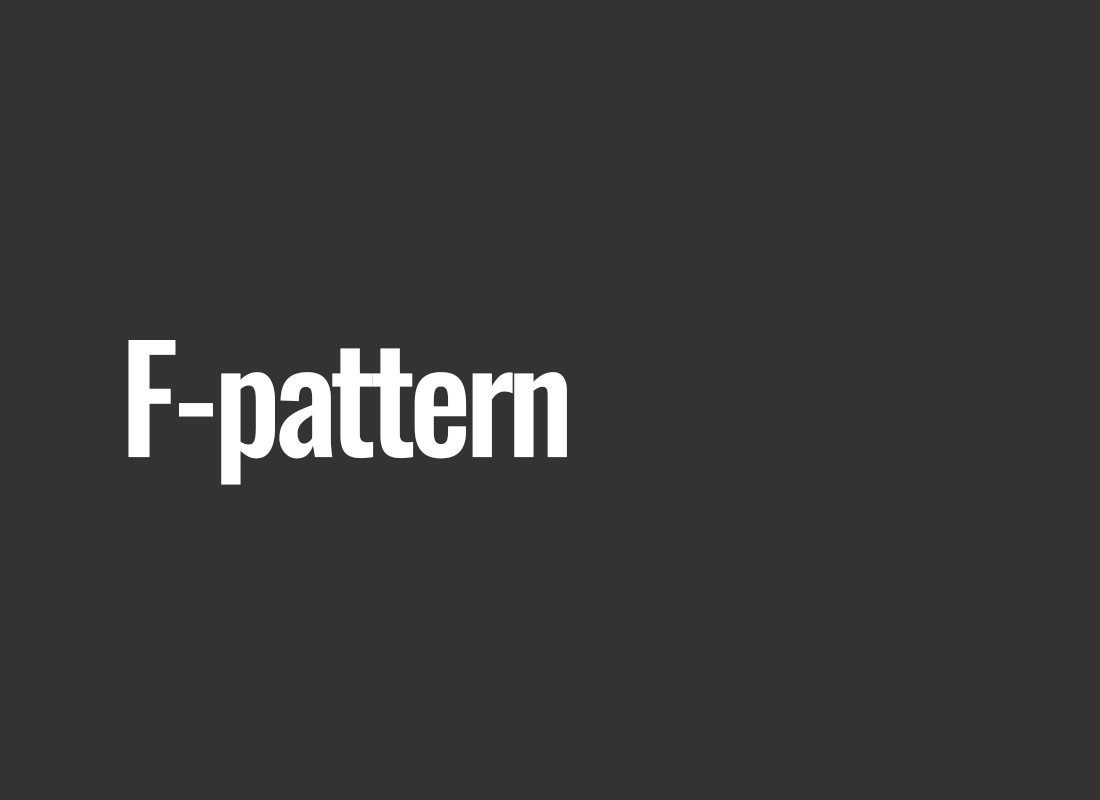F-pattern
The F-pattern, also known as the F-scan model, is a key concept in the field of User Experience (UX) and web design, referring to the way internet users read content on web pages. This pattern was first identified and documented by researchers from the Nielsen Norman Group, a leading consulting firm in usability. The F-pattern describes that while browsing web pages, most users focus their attention on the top part of the page, then move their gaze to the right, and then down the page, thus creating a shape resembling the letter "F".
This scanning model is a result of natural reading tendencies in cultures where writing is organized from left to right and top to bottom. Users typically start by scanning horizontally at the top of the page, creating the top bar of the F. Then, their gaze moves down the page, stopping briefly to scan the content horizontally again, creating the second bar of the F. Finally, the user's gaze moves down the left side of the page, forming the vertical part of the F.
Understanding the F-pattern is extremely important for web designers, content creators, and digital marketing specialists. It allows them to better understand user behaviors and adjust the design of web pages and content in such a way that the most important information is presented where users are most likely to focus their attention. Therefore, the F-pattern has a direct impact on the effectiveness of communication on web pages, influencing how content is received and assimilated by users.
However, the F-pattern is not universal for every web page or every user. Scanning patterns can vary depending on the context, type of content, and individual user preferences. Nevertheless, the F-pattern is a valuable starting point for understanding general tendencies in reading digital content and is a fundamental element in designing user-friendly web pages.
F-Pattern in Web Design
The F-pattern in web design plays a key role as it provides designers and content creators with insight into how users interactively browse web pages. Understanding this pattern allows for the optimization of page layout, placing the most important elements in areas that are most frequently scanned by users, increasing the chances that key information will be noticed and read.
How the F-pattern Affects Page Layout?
- Placing Key Information. The F-pattern suggests that the most important information should be placed at the top of the page and at the beginning of each line. This means that headers, key messages, and call-to-action (CTA) should be located in these areas to increase their visibility.
- Designing for Scanning, Not Reading. Most users scan content, rather than reading every word. Therefore, it is important for content to be easy to scan. The use of headers, bullet points, short paragraphs, and highlighted text can help users quickly understand the main points of the page.
- Importance of the Left Side of the Page. Since the vertical part of the F-pattern is on the left side, it is important to place important elements, such as logos, navigation, and key links, on the left side of the page.
Optimizing Content for the F-Pattern
- Headers and Subtitles. Using catchy and informative headers that attract attention and quickly convey the main message of the content.
- Highlighted Keywords. Using bold or color to highlight important keywords can help attract the user's attention while scanning the content.
- Use of Images and Graphics. Images and graphics can attract the user's eye and encourage further scanning of the content. It is important that they are appropriately placed and related to the text.
Impact of the F-Pattern on Responsive Design
The F-pattern is also significant in the context of responsive design. As more and more users use mobile devices, designers must consider how the F-pattern changes on smaller screens. On mobile devices, the scanning pattern may be more vertical, but it is still important for key information to be easily accessible and visible without the need for scrolling.
The F-pattern is not a fixed rule, but rather a guideline that can help create more intuitive and effective web page designs. Understanding this pattern and adapting design and content to it can significantly improve user experiences and the effectiveness of the website.
Summary
In the context of continuous technological development and changing user behaviors, the future of the F-pattern in UX design seems dynamic. On one hand, the basic principles of the F-pattern remain important as they reflect the natural tendencies of human vision and information processing. On the other hand, the growing popularity of mobile devices and diverse digital content formats may lead to the evolution or adaptation of this pattern. UX designers and content creators will need to continuously monitor and analyze user behaviors to adjust their strategies to evolving scanning patterns. The F-pattern may evolve, but its basic principle - understanding and anticipating how users interact with content - will remain key to effective design.
Ultimately, the F-pattern should be seen as one element in a broader UX design strategy, not as a universal solution. Its application should be balanced with other research and insights into user behaviors, such as user path analysis, A/B testing, and usability studies. The F-pattern provides valuable guidelines, but best practices in UX design require a holistic approach that considers the diversity of users and their needs. As technology and user expectations evolve, so too will design methods and strategies to create even more engaging and intuitive user experiences.




